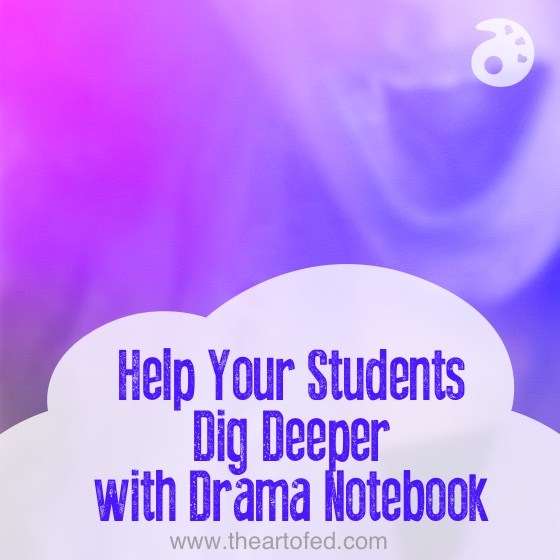I’ve been thinking recently about some possibilities for cross-curricular connections for my classroom. Generally, my ideas gravitate toward the “core” subjects: Language Arts, Math, Science, and Social Studies. While those subjects inherently align with art, I realized my attention could turn to another subject and another question: what can I do with performing arts–like Drama–in my art room? Now, I’m not talking about little-d drama; if you teach high school, you know I have plenty of that going on in my room. I’m thinking about big-D Drama: acting, performing, doing.
I wondered, “Could I bring those skills into my art room?”
When I was introduced to the website Drama Notebook, I knew I had found my answer. The site has a plethora of ideas, activities, and games that can be brought into any classroom, including a free set of 40 different Drama games for your students. Best of all, drama outreach expert and author of Drama Notebook, Janea Dahl was kind enough to answer my questions about the best ways to bring these two disciplines together. It turns out the subject she loves and the subject I love can converge in a multitude of fun and interesting ways. Below is what I learned.
Drama Helps Build Community in the Classroom
First, Janea and I talked about the importance of building a community in your classroom. I start some community building activities very early in the year–sometimes on the first day–but almost always have trouble with students opening up and being willing to participate, no matter how exciting the activity may be. Dahl, however, said this is natural, saying “students are reluctant to share their creativity when they do not feel trusting of the group as a whole . . . It is essential for actors to feel truly supported by one another before they can deliver a strong performance.” There are a number of games on the Drama Notebook site that work incredibly well for ice-breaking and community building.
Drama Can Amp Up Student Portraits
The discussion about performance got me thinking a bit about portraits. If your students are anything like mine, they pose for portraits with uninspiring looks, making it difficult to do portraits with any sort of visual interest. “Indicating” was the word that Dahl used to describe these inauthentic faces. Dahl explained this idea further: “For example, if a scene calls for one person to be very angry, the actor may raise his voice and shake his fist at the other character to show that he is angry. Not only might this feel inauthentic, it may be the wrong choice for his character. Many people show anger by lowering their voices or by distancing themselves.”
To help with authenticity, Dahl challenges her students to respond to prompts with a wide range of different emotions and ideas, like anger, sadness or boredom. This idea could be incredibly helpful when you are looking to inspire students when portrait time rolls around in your classroom. If you need something quick and simple, Dahl had a suggestion to, “Ask students to think of someone they have strong feelings about and ask them to imagine that the person is sitting right in front of them. Or, ask students to imagine becoming that person!” These ideas can help students create an interesting “look” from which to work.
Drama Can Inspire a Meaningful Gesture Drawing Session
The last art class activity I asked for suggestions with was figure drawing, particularly gesture drawing, because I always like to make sure those poses aren’t stiff, stale or cliche. Dahl suggested letting kids pick prompts out of a hat, then getting specific: “For example, if they pulled, “wiping away a tear,” ask them to think about what had made them cry. If they are hailing a cab, ask them to imagine their precise location and circumstance.” A few ideas she shared:
- Wiping away a tear
- Scratching an itch
- Holding a butterfly on your hand
- Blowing a kiss
- Hailing a cab
- Blowing warm air into your cold hands
- Wiping your brow
- Pointing a ‘naughty’ finger at someone
I tried almost all of the ideas Dahl shared, and all in all, my kids really enjoyed incorporating drama as part of the artmaking process. They enjoyed trying something different, and I think it will lead to some interesting work. Again, I would encourage you to check out Drama Notebook for some ideas on how you can bring this into your classroom–at any level. And I would like to leave you with some words Dahl wanted to share with all the art teachers out there:
“I would like to thank the amazing art teachers who are dedicating themselves to helping kids embrace their creativity.
I believe that one very powerful way to heal our world is to inspire the younger generation to imagine and create a different future—a future where each person is safe, loved, seen and nourished. I know that sounds idealistic. But every day, I work to make my contribution to that vision. I send out my creativity and love to young people through their amazing teachers who are doing what I believe to be one of the most important jobs in the world.
Thank you for letting me share with you and your readers!”
If you’re interested in reading the interview in its entirety, including more specific suggestions for the classroom, head on over to my blog eastartroom!
Do you use any other performing arts in your classroom?
Do you have a favorite drama game to share?
Magazine articles and podcasts are opinions of professional education contributors and do not necessarily represent the position of the Art of Education University (AOEU) or its academic offerings. Contributors use terms in the way they are most often talked about in the scope of their educational experiences.





